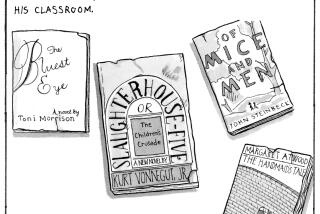‘The Case for Books’ by John Darnton
The Case for Books
Past, Present, and Future
Robert Darnton
PublicAffairs: 210 pp., $23.95
It’s all a bad dream. You wake up in a strange world with no books, no paper, only screens. The monitors, like the fabled red shoes, cannot be turned off. Book historian Robert Darnton to the rescue: Blam! Take that, Google, you blood-sucking monopoly! You fiend! Kerpow!
Down go librarians who hope to save space by throwing away newspapers and even books, relying on not-so-reliable microfilm. Darnton laughs in the face of those who claim the book is dead. One million new titles, he writes, are published each year! (Sigh. My hero!)
Darnton is as serious as I am silly. He builds a case, essay by essay, for a future collaboration between books and the Internet. He banishes the nightmare, if only for a while:
“Consider the book. It has extraordinary staying power. Ever since the invention of the codex sometime close to the birth of Christ, it has proven to be a marvelous machine -- great for packaging information, convenient to thumb through, comfortable to curl up with, superb for storage, and remarkably resistant to damage. It does not need to be upgraded or downloaded, accessed or booted, plugged into circuits or extracted from webs. Its design makes it a delight to the eye. Its shape makes it a pleasure to hold in the hand. And its handiness has made it the basic tool of learning for thousands of years.”
The Metamorphosis
of Plants
Johann Wolfgang von Goethe
Introduction and photographs by Gordon L. Miller
The MIT Press: 124 pp., $21.95
In 1786, when he was 37 and famous, Goethe took a trip to Italy, where he studied the metamorphosis of plants from a single seed into the myriad shapes and colors that sprang from that first impulse, what he called the proteus. Fiction was his avocation. Botany, geology, meteorology, zoology and physics were his focus.
Goethe identified his method as scientific and poetic, using “The eyes of the mind” as well as the eyes of the body. He wrote in “Faust,” quotes Miller in his introduction, of the “harmony or identity between the human spirit and the informing spirit of nature, wherein ‘speaks one spirit to the other.’ ”
This book, published in 1790, consists of 123 numbered paragraphs, a sequel included illustrations commissioned by the author. But it was never fully illustrated. This edition, with Miller’s luminous photographs (in many, the plants are positioned against pitch-black backgrounds like jewels in the night), fulfills the author’s vision.
Looking for Calvin
and Hobbes
The Unconventional Story of Bill Watterson and His Revolutionary Comic Strip
Nevin Martell
Continuum: 256 pp., $24.95
This story of Nevin Martell’s search for the elusive Bill Watterson, the J.D. Salinger of the cartoon world, is so richly infused with the spirit of “Calvin and Hobbes,” the genuine innocence and affection and humor, it doesn’t even matter that the author never meets his subject. Watterson has never allowed the licensing of his work -- no merchandise, no TV, no movies. After doing a few interviews in the 1980s, he wrote a “manifesto against celebrity”: “People love to have you, and then they use you up and there’s nothing left.” Early on, Martell wrote Watterson, who disappeared from public life after he stopped writing the strip in 1995, but never heard back. Discouraged but determined, he researched Watterson’s life, interviewed friends, editors, even Watterson’s mother, visited Watterson’s childhood home in Chagrin Falls, Ohio, talked with other cartoonists, studied the influence of Peanuts, Krazy Kat, Pogo and Winnie the Pooh and pondered the effect of “Calvin and Hobbes” on his own life. Is this a definitive biography? No. But it’s in many ways better and truer to the spirit of Watterson’s creation.
More to Read
The biggest entertainment stories
Get our big stories about Hollywood, film, television, music, arts, culture and more right in your inbox as soon as they publish.
You may occasionally receive promotional content from the Los Angeles Times.






